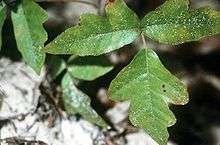Toxicodendron pubescens
| Atlantic poison oak | |
|---|---|
 | |
| Scientific classification | |
| Kingdom: | Plantae |
| (unranked): | Angiosperms |
| (unranked): | Eudicots |
| (unranked): | Rosids |
| Order: | Sapindales |
| Family: | Anacardiaceae |
| Genus: | Toxicodendron |
| Species: | T. pubescens |
| Binomial name | |
| Toxicodendron pubescens Mill. | |
| Synonyms | |
| |
Toxicodendron pubescens (syn. Rhus pubescens), commonly known as Atlantic poison oak,[1] is an upright shrub that can grow to 1 m (3 ft) tall. Its leaves are 15 cm (6 in) long, alternate, with three leaflets on each. The leaflets are usually hairy and are variable in size and shape, but most often resemble white oak leaves; they usually turn yellow or orange in autumn. The fruit is small, round, and yellowish or greenish. It is not closely related to true oaks.
Distribution
This species is native to the Southeastern United States from Virginia[2] westward to Texas and Oklahoma.
Habitat
Atlantic poison oak can be found growing in forests, thickets, and dry, sandy fields.
Contact dermatitis
All parts of this plant contain urushiol, which can cause severe dermatitis in sensitive individuals. The risk of exposure may be reduced by learning to recognize and avoid this species and wearing clothing that covers the legs and arms. Contaminated clothing should be laundered before subsequent handling or use.
Effects
Effects of poison oak are similar to those of poison ivy. It first causes severe itching, evolves into inflammation, non-colored bumps, and then blistering when scratched.
See also
References
- ↑ "Toxicodendron pubescens". Natural Resources Conservation Service PLANTS Database. USDA. Retrieved 11 December 2015.
- ↑ Digital Atlas of the Virginia Flora: Toxicodendron pubescens.